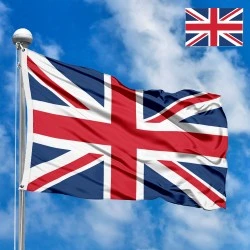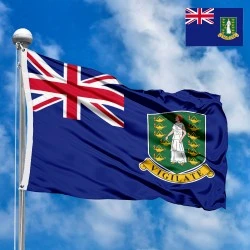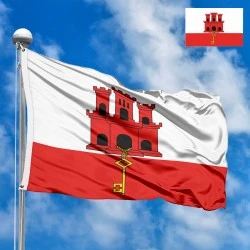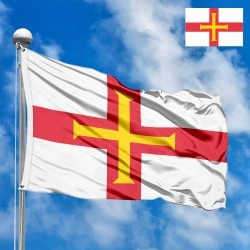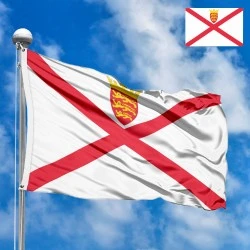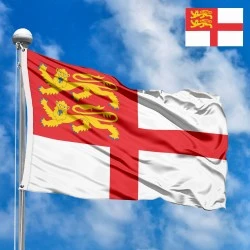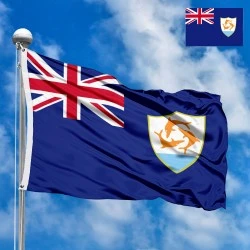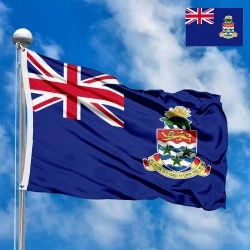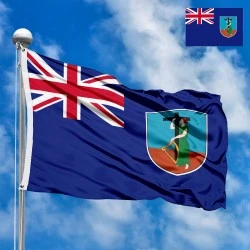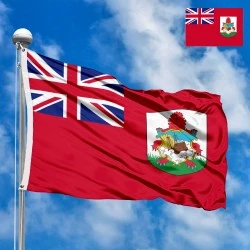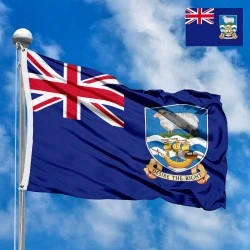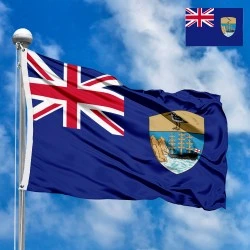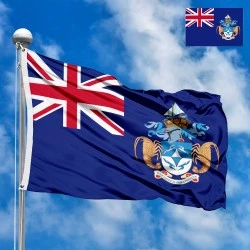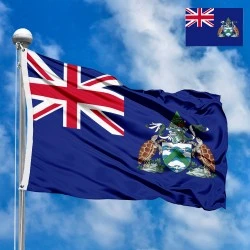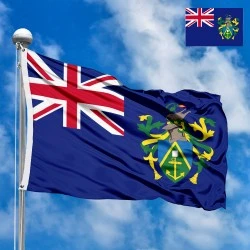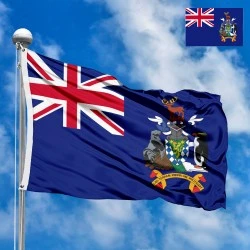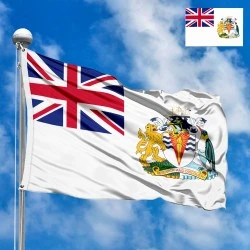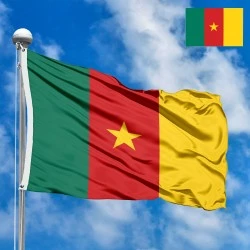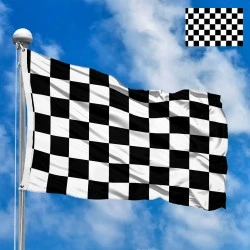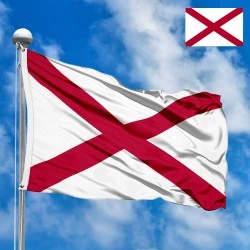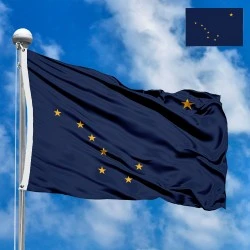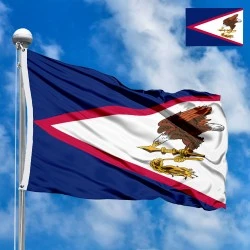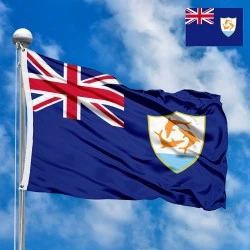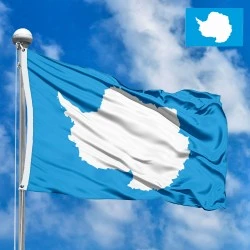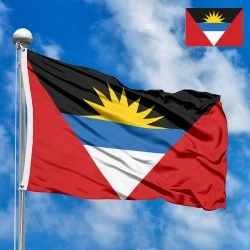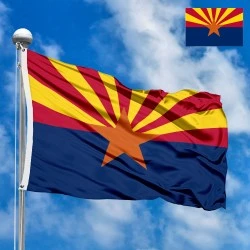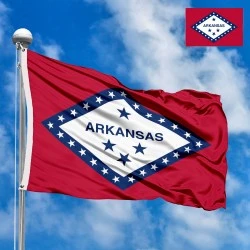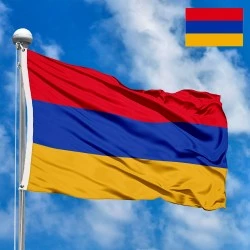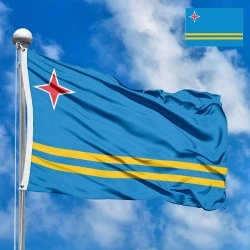Flag of the British Indian Ocean Territory
- Flag Type: Regional
- Proportions (official): 1:2
- Official name: British Indian Ocean Territory
- Local name: British Indian Ocean Territory
- Sovereignty (year): NO (British Overseas Territory since 1965)
- Country code, territory: IO, IOT, 086
- Capital: Camp Justice (Diego Garcia)
- Population: ~3,000 (2024, est.)
- Area (km²): 60
- Highest point: Unnamed point on Diego Garcia (2 m)
- Lowest point: Indian Ocean (0 m)
- Currency: Pound sterling (GBP, £)
- Languages: English
- Dialing code: +246
- National domain: .io
Flag Information
General information
Demography and Culture
Economy and communications
- All Flags
- Flags of Countries by Continent
-
Flags of Organizations
- Flags of UN countries
- Flags of the European Union countries
- Flags of NATO countries
- Flags of the countries of the Organization of Islamic Cooperation
- Flags of the countries of the Organization of American States
- Flags of the Arab League countries
- Flags of the African Union countries
- Flags of the countries of the Union of South American Nations
- Flags of the Commonwealth of Nations
- Flags of the countries of the Secretariat of the Pacific Community
- Flags of the Nordic Council countries
- Flags of the Caribbean Community
- Flags of the countries of the Association of Southeast Asian Nations
- Flags of the East African Community
- Flags of the countries of the Organization of Turkic States
- LGBT Community Flags
- Historical Flags
- Ethnic Flags
- Flags of the USA (states)
Description
The Flag of the British Indian Ocean Territory (BIOT) is a distinctive emblem representing one of the United Kingdom's most remote and strategically important overseas territories. This flag, though less widely known than many national flags, holds significant symbolic weight for the territory and its administration, particularly given the unique nature of its population and historical context.
Dimensions, Colors, and Arrangement of Elements
The Flag of the British Indian Ocean Territory is a visually striking ensign, combining traditional British vexillological elements with specific symbols relevant to the territory.
-
The flag uses a blue field, consistent with a blue ensign often used by British territories and organizations. This blue is typically a deep, rich shade, evoking the vastness of the Indian Ocean.
-
It features the Union Flag (the flag of the United Kingdom) prominently in the canton (the upper hoist quarter). This inclusion unequivocally signifies the territory's status as a British Overseas Territory, maintaining a direct constitutional link to the UK.
-
The remainder of the blue field is adorned with a pattern of white wavy lines, which symbolize the waves of the Indian Ocean. These lines are typically depicted horizontally and subtly underscore the maritime nature of the territory.
-
A central, and perhaps the most iconic, element of the flag is a coconut palm tree rising from a grassy base, positioned above a St. Edward's Crown (the Royal Crown of the United United Kingdom), both rendered in yellow.
-
The coconut palm tree is a direct representation of the flora and natural environment of the atolls and islands that comprise the territory, particularly emphasizing the iconic nature of the palm.
-
The St. Edward's Crown is a clear symbol of royal authority and sovereignty, further cementing the territory's bond with the British Crown.
-
-
The flag's proportions typically adhere to the standard British ensign ratio, often 1:2.
History of the Flag's Creation and Adoption
The creation and adoption of the BIOT flag are intertwined with the territory's establishment and its specific administrative needs.
-
Establishment of BIOT (1965): The British Indian Ocean Territory was officially established on November 8, 1965. Prior to this, the islands that now form BIOT were dependencies of the Seychelles and Mauritius. The formation of BIOT was a strategic move by the United Kingdom, primarily to facilitate the construction of a major US military base on Diego Garcia, the largest island in the Chagos Archipelago.
-
Initial Use of UK Flag: In its very early days, and for general representation, the Union Flag (UK flag) would have been the primary symbol. However, as a distinct territory, a unique ensign was eventually deemed necessary.
-
Creation of the Flag (1990): The current flag of the British Indian Ocean Territory was officially adopted on January 24, 1990. Its design was approved by Queen Elizabeth II. The creation of a specific flag for BIOT was part of a broader trend among British Overseas Territories to adopt their own distinct symbols, often incorporating local elements while retaining the Union Flag to denote their British status.
-
Evolution of the Design: The design elements – the blue field, the Union Flag, the wavy lines, the palm tree, and the crown – were carefully chosen to represent the territory's unique geography, its colonial heritage, and its administrative status. The wavy lines and the palm tree directly reflect the islands' environment and their identity as tropical atolls in the Indian Ocean. The crown and the Union Flag clearly articulate its British sovereignty.
-
No Wider Public Adoption: Given that the territory has no permanent civilian population (due to the controversial removal of the Chagossians, discussed below), the flag's adoption was primarily an administrative and symbolic act for the governance of the territory and its military presence, rather than a reflection of popular will.
Symbolism and Meaning for Residents (and those associated with BIOT)
The concept of "residents" for BIOT is complex due to the unique demographic situation.
-
For the BIOT Administration and British Military/Civilians on Diego Garcia:
-
Sovereignty and Authority: For the British administration, military personnel, and contractors stationed on Diego Garcia, the flag is a clear and unambiguous symbol of British sovereignty and authority over the territory. It represents the legal framework and governance under which they operate.
-
Territorial Identity: It helps define the unique identity of the territory as distinct from the UK mainland or other British Overseas Territories, emphasizing its geographical location and purpose.
-
Pride and Service: For those serving in the military or working in the administration, it can evoke a sense of pride in their service and their role in maintaining this strategically important outpost.
-
-
For the Displaced Chagossians (Former Residents):
-
Controversial Symbol: For the Chagossian people, who were forcibly removed from the islands in the late 1960s and early 1970s to make way for the military base, the flag is a deeply controversial and painful symbol. It represents the loss of their homeland, displacement, and the denial of their right to return.
-
Colonialism and Injustice: For Chagossians and their supporters, the flag can be seen as a symbol of colonialism, historical injustice, and ongoing human rights abuses. It embodies the power structure that led to their expulsion and continues to deny them resettlement.
-
Aspiration for Return: While they may not embrace the flag, their struggle often involves efforts to influence the British government, whose flag (the Union Flag) is embedded within the BIOT flag, to recognize their rights and facilitate their return.
-
-
For the Global Community (Strategic Perspective):
-
Geopolitical Presence: For international observers, particularly those interested in geopolitics and military strategy, the flag signifies the presence of the United Kingdom and, by extension, the United States in a critical part of the Indian Ocean. It denotes a hub for military operations and intelligence gathering.
-
Interesting Facts
The British Indian Ocean Territory and its flag are associated with several unique and often controversial facts.
-
Only One Inhabited Island (for non-Chagossians): Of the many islands and atolls that make up BIOT, only Diego Garcia is inhabited, primarily by British and American military personnel and contractors. The rest of the territory is largely uninhabited and consists of protected marine areas.
-
Controversial History of Displacement: The territory is infamous for the forced removal of the indigenous Chagossian population by the British government between 1967 and 1973 to allow for the construction of the US military base on Diego Garcia. This act has been widely condemned internationally as a human rights violation and remains a significant point of contention.
-
Largest Marine Protected Area (MPA): In 2010, the entire territory was declared a marine protected area (MPA), encompassing over 640,000 square kilometers. This makes it one of the largest marine reserves in the world, aimed at conserving its pristine coral reefs and diverse marine life. This designation, however, is also controversial, as critics argue it serves to further prevent Chagossians from returning.
-
Strategic Military Importance: Diego Garcia hosts the Naval Support Facility Diego Garcia, a joint US-UK military base that is of immense strategic importance. It has played a critical role in various military operations, including those in the Middle East and Afghanistan, due to its central location in the Indian Ocean.
-
Unique Flora and Fauna: Despite its military presence, BIOT boasts incredible biodiversity, including a rich array of coral reefs, seabirds, and marine life. The territory is a vital habitat for many species, including rare sea turtles and numerous fish species.
-
World Court Ruling (Advisory Opinion): In 2019, the International Court of Justice (ICJ) issued an advisory opinion stating that the UK's administration of the Chagos Archipelago, including Diego Garcia, was unlawful and that the UK should end its administration "as rapidly as possible." This ruling, while non-binding, has intensified international pressure on the UK regarding the territory's future and the Chagossian people's rights.
-
United Nations General Assembly Resolution: Following the ICJ ruling, the UN General Assembly passed a resolution in May 2019, overwhelmingly backing the ICJ's opinion and demanding that the UK "unconditionally withdraw its colonial administration" from the Chagos Archipelago.
-
Symbol of Persistence: For the Chagossian diaspora, the flag, while representing their displacement, also indirectly symbolizes their persistence and ongoing struggle for justice and the right to return to their homeland.
-
Limited Public Visibility: Unlike national flags seen daily by millions, the BIOT flag has very limited public visibility outside of official government and military contexts. It is rarely seen by the general public globally.
-
Part of the Commonwealth: Despite its unique status and controversies, BIOT is part of the British Commonwealth, further linking it to a network of nations with historical ties to the United Kingdom.
In the demonstration images, full-size flags are shown with proportions of 2:3, and hand-held flags with proportions of 1:2.
Donation
Download
Completely free for commercial and non-commercial use (public domain).
You can freely use them in your news magazines, websites, software, mobile applications.
We appreciate a backlink to https://flagssite.com
Raster files - Flag of the British Indian Ocean Territory (PNG, JPG)
 Waving flag
Waving flag
- PNG format (transparent background), 72dpi, dimensions in Pixels (px), aspect ratio 3:4.
- 15х20 px
- 30х40 px
- 60х80 px
- 120x160 px
- 240x320 px
 Sizes:
Sizes:
"v15" - image size (by height); if necessary, replace with available: v15, v30, v60, v120, v240.
!!! For resizing, use the Latin (eng) keyboard layout.
<img src="https://flagssite.com/flags/v15/20354.png" alt="Flag of the British Indian Ocean Territory">
 Round flag
Round flag
- PNG format (transparent background), 72dpi, dimensions in Pixels (px), aspect ratio 1:1.
"d15" - image size (diameter); if necessary, replace with available: d15, d30, d60, d120, d240.
!!! For resizing, use the Latin (eng) keyboard layout.
<img src="https://flagssite.com/flags/d15/20354.png" alt="Flag of the British Indian Ocean Territory">
 Rectangular flag 2:3
Rectangular flag 2:3
- JPG format, 72dpi, dimensions in Pixels (px), aspect ratio 2:3.
"h30" - image size (by height); if necessary, replace with available: h15, h30, h60, h120, h240, h360, h480.
!!! For resizing, use the Latin (eng) keyboard layout.
<img src="https://flagssite.com/flags/h30/20354.jpg" alt="Flag of the British Indian Ocean Territory">


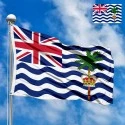
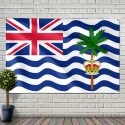
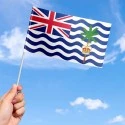

 Sizes:
Sizes:
 Sizes:
Sizes:
